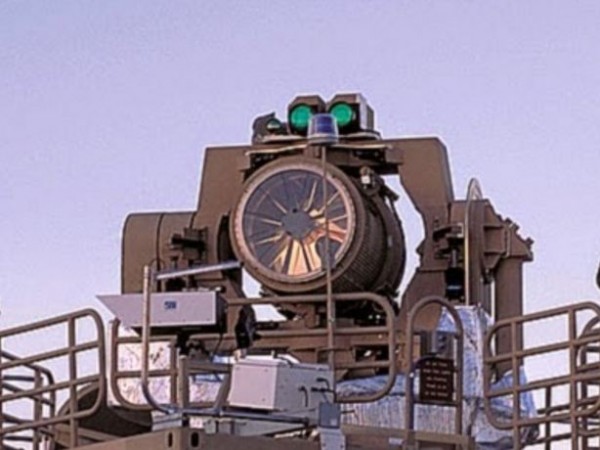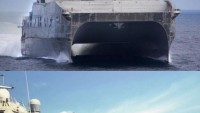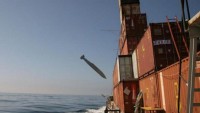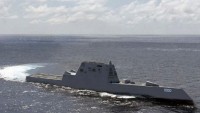US Navy Speeds-up Development of 150 kW Warship Laser Weapon
| Arthur Dominic Villasanta | | Jun 29, 2016 02:32 AM EDT |
(Photo : US Navy) LaWS
The U.S. Navy has decided to massively boost the power of its ship borne laser by five times and plans to see the first demonstration of this new weapon by 2018.
The Navy's Office of Naval Research (ONR) will perform a shipboard test of a 150 kilowatt solid-state laser weapons system, said Admiral Bill Moran, Vice Chief of Naval Operations, at a recent meeting in Washington, D.C.
Like Us on Facebook
ONR coordinates, executes and promotes the science and technology programs of the U.S. Navy and Marine Corps.
The upshift to a 150 kW solid state laser marks a huge leap from today's testing regime begun in 2014 where the Navy began firing a 30 kW prototype Laser Weapon System, or LaWS, aboard the USS Ponce at sea trials. LaWS, which has been used operationally in the Persian Gulf, gives the U.S. Navy precision accuracy at a low cost.
Once accepted into service between 2017 and 2021, the 30kW LaWS will enable the Navy to effectively neutralize aerial drones, swarm boats and other threats by destroying or crippling them with an intense beam of laser heat that melts internal circuitry and machinery.
In operation, the 30 kW LaWS can be aimed accurately at targets by a U.S. Navy warship's Phalanx close-in-weapons-system (CIWS) radar. LaWS has an effective range of 1.6 kilometers.
LaWS uses a solid-state infrared laser beam that can be tuned to high output to destroy a target or to a low output to warn or cripple the sensors on a target. Its power output is estimated between 15kW to 50kW for engaging small aircraft and high-speed boats.
The LaWS being tested aboard the USS Ponce isn't designed to engage incoming missiles, large aircraft, surface warships or submarines, however. This capability will be left to the 150 kW LaWS whose development the Navy has just decided to speed-up.
LaWS is finding favor within the US armed forces because its laser light "ammunition" is cheaper than conventional explosive rounds. It laser light beams can be fired for as little as one dollar per shot, while conventional rounds and missiles cost thousands of dollars each.
The U.S. Army, Navy and Air Force all plan to deploy laser weapons by the next decade. The Army intends to have lasers deployed by 2023, with tests of lasers mounted on attack helicopters taking place this summer.
The Air Force will test its first airborne combat lasers on AC-130 gunships and modified C-17 Globemaster cargo aircraft by 2021. This will be a prelude to deploying smaller but powerful lasers on jet fighter aircraft such as the F-35 and F-15 and on aerial drones.
The Marine Corps, along with the Navy, is also developing truck-mounted lasers to protect Marines.
TagsU.S. Navy, 150 kilowatt solid-state laser, Laser Weapon System, USS Ponce
©2015 Chinatopix All rights reserved. Do not reproduce without permission
EDITOR'S PICKS
-

Did the Trump administration just announce plans for a trade war with ‘hostile’ China and Russia?
-

US Senate passes Taiwan travel bill slammed by China
-

As Yan Sihong’s family grieves, here are other Chinese students who went missing abroad. Some have never been found
-

Beijing blasts Western critics who ‘smear China’ with the term sharp power
-

China Envoy Seeks to Defuse Tensions With U.S. as a Trade War Brews
-

Singapore's Deputy PM Provides Bitcoin Vote of Confidence Amid China's Blanket Bans
-

China warns investors over risks in overseas virtual currency trading
-

Chinese government most trustworthy: survey
-

Kashima Antlers On Course For Back-To-Back Titles
MOST POPULAR
LATEST NEWS
Zhou Yongkang: China's Former Security Chief Sentenced to Life in Prison

China's former Chief of the Ministry of Public Security, Zhou Yongkang, has been given a life sentence after he was found guilty of abusing his office, bribery and deliberately ... Full Article
TRENDING STORY

China Pork Prices Expected to Stabilize As The Supplies Recover

Elephone P9000 Smartphone is now on Sale on Amazon India

There's a Big Chance Cliffhangers Won't Still Be Resolved When Grey's Anatomy Season 13 Returns

Supreme Court Ruled on Samsung vs Apple Dispute for Patent Infringement

Microsoft Surface Pro 5 Rumors and Release Date: What is the Latest?














